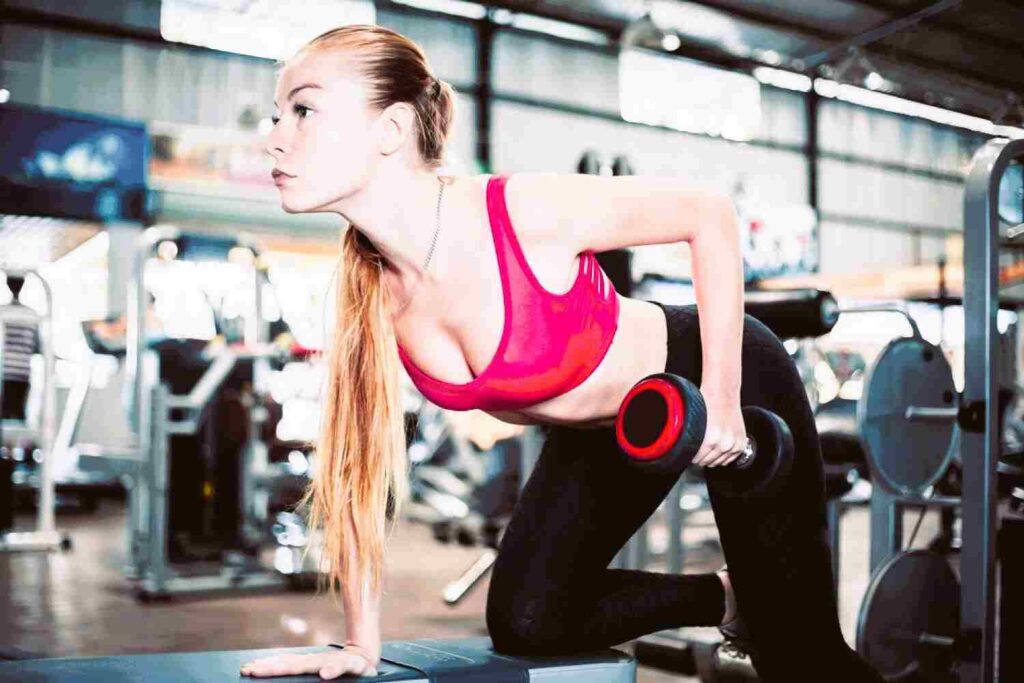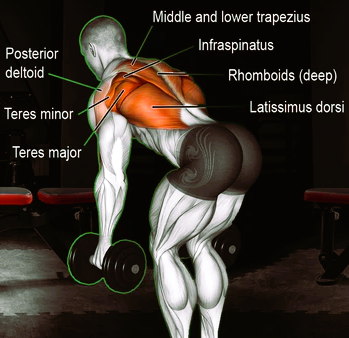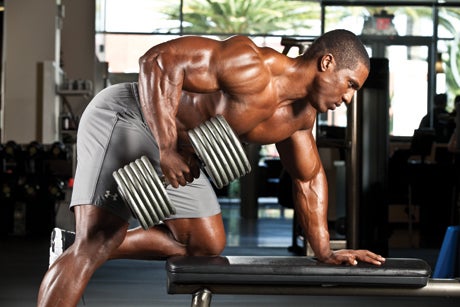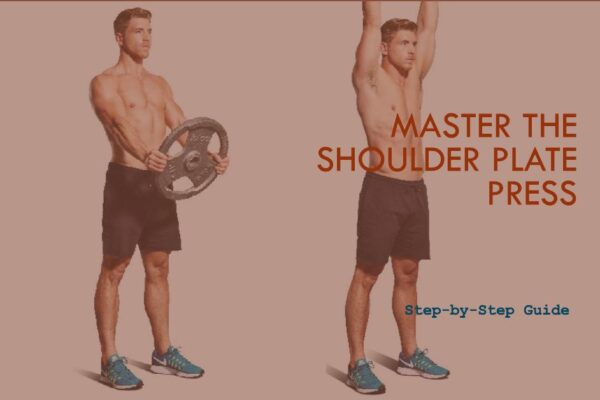When someone thinks about having a strong and well-defined back, one exercise that staples the work routine is the One-arm dumbbell row. This exercise not only targets your lats but also engages many other muscles present in the upper body. In this article, we will discuss the importance of one-arm dumbbell row in a fitness routine, muscles worked, benefits, step-by-step instructions, common mistakes to avoid, variations, tips to maximize the results, and FAQs.

What is a One-arm dumbbell row?
One-arm dumbbell row, commonly called the Single-arm dumbbell row, is a compound exercise that mainly targets the lat muscles in the back. It also helps strengthen the biceps and shoulders. This exercise involves using a dumbbell with one hand while bracing yourself with the opposite hand and a knee on the bench or a sturdy surface. The one-arm dumbbell row is excellent for building back strength, improving posture, and enhancing the aesthetics of the upper body.
Importance of One-Arm Dumbbell Row
We all know that being strong is essential for performing daily activities and maintaining a good posture. To keep the back strong, one exercise that comes to mind is a One-arm dumbbell row. One-arm dumbbell row is a crucial exercise that plays a significant role in the development of lats, rhomboids, and trapezius muscles. This exercise helps prevent the injuries and ensures the symmetrical muscle development. Overall this exercise really helps to enhance your overall fitness.

Muscle Worked by the Single-Arm Dumbbell Row
When you perform the one-arm dumbbell row effectively, you engage many muscle groups simultaneously. Below are the targeted muscles when performing the one-arm dumbbell row:
- Latissimus Dorsi (Lats)
- Rhomboids
- Trapezius

Benefits of dumbbell rows
Back Muscle Strengthening
This exercise targets the muscles of the back, including your grip and forearm muscles, leading to improved back strength.
Posture Improvement
One-arm dumbbell rows can assist in correcting rounded shoulder posture caused by bad posture habits.
Lats Isolation
Focusing on one arm at a time allows for better isolation of the latissimus dorsi (lats), which can result in lifting heavier weights compared to the classic barbell row.
Enhanced Range of Motion
Placing your free hand on your thighs or another stable surface enables you to lift more weight. However, it’s essential to remember that the primary goal of this exercise is to maximize the range of motion rather than simply lifting heavier weights.
Versatility
One-arm dumbbell row can be performed with minimal equipment use, which makes it accessible for both gym-goers and home exercisers.
How to Do the One-Arm Dumbbell Rows

Set-Up
- Stand next to a bench with your feet shoulder-width apart.
- Place your left knee and left hand on the bench for support.
- Hold a dumbbell in your right hand, allowing it to hang at arm’s length.
Execution
- Keep your back straight and your core engaged.
- Pull the dumbbell toward your hip, keeping your elbow close to your body.
- Squeeze your back muscles at the top of the movement.
- Lower the dumbbell back to the starting position with control.
- Complete the desired number of repetitions on one side before switching to the other.
Breathing Pattern
Inhale as you lower the dumbbell, and exhale as you lift it. Maintain controlled breathing throughout the exercise to support your core and maintain stability.
Sets and Rest
Perform two to three sets of the exercise, with a one-minute rest between sets.
Common mistakes you should avoid
Avoid mistakes while performing one-arm dumbbell row so that you may prevent strain or injury.
Lifting Too Much Weight
If you’re new to this exercise, avoid lifting excessive weight. Begin with lighter weights and perform more repetitions while focusing on squeezing your shoulder blades during the movement. Once you’ve mastered the proper form and full range of motion, gradually increase the weight and reduce the number of repetitions.
Moving the Shoulder, Not the Arm
To initiate the row, move your shoulder blade, not your arm.
Avoid Jerking or Twisting Motion
Steer clear of twisting your spine or jerking the weight. If you find yourself doing this, it’s a sign that you’re using too much weight.
Maintain a Straight Back
Ensure your back remains straight and avoid rounding or curving it during the One-arm dumbbell rows exercise.
Variations of Single-Arm Dumbbell Row
Single-arm rows or bent-over one-arm dumbbell rows can be performed in different ways depending on your needs and skill level. You may perform this exercise by aligning yourself perpendicular to an exercise bench and placing your free hand on the bench to support yourself. Here are a few of the variations of one-arm dumbbell row
Symmetrical Stance One-arm Dumbbell Rows
- Stand squarely on the exercise bench with your feet shoulder-width apart.
- Hold a dumbbell in one hand while keeping the other hand free.
- Maintain a straight back and engage your core for stability.
- Perform the rowing motion by pulling the dumbbell toward your hip while keeping your elbow close to your body.
- Squeeze your back muscles at the top of the movement.
- Lower the dumbbell back to the starting position with control.
- Complete the desired number of repetitions on one side before switching to the other.
Gym Ball One-arm Dumbbell Row
- Sit on an inflatable gym ball with your feet flat on the ground and shoulder-width apart.
- Hold a dumbbell in one hand while keeping the other hand free.
- Maintain balance on the gym ball by engaging your core muscles.
- Perform the rowing motion by pulling the dumbbell toward your hip while keeping your elbow close to your body.
- Squeeze your back muscles at the top of the movement.
- Lower the dumbbell back to the starting position with control.
- Complete the desired number of repetitions.
Kneeling Single-arm Dumbbell Row
- Begin by kneeling on a bench or mat with one knee and placing the same-side hand on the bench for support.
- Hold a dumbbell in your free hand, allowing it to hang at arm’s length.
- Maintain a straight back and engage your core.
- Perform the rowing motion by pulling the dumbbell toward your hip while keeping your elbow close to your body.
- Squeeze your back muscles at the top of the movement.
- Lower the dumbbell back to the starting position with control.
- Complete the desired number of repetitions on one side before switching to the other.
T-Bar Row Machine Single-arm Rows
Procedure:
- Stand facing the T-Bar Row machine with a handle attachment set at an appropriate height.
- Hold the handle with one hand while keeping your knees slightly bent and your back straight.
- Maintain a strong core as you perform the rowing motion by pulling the handle toward your hip while keeping your elbow close to your body.
- Squeeze your back muscles at the top of the movement.
- Slowly release the handle back to the starting position.
- Complete the desired number of repetitions on one side before switching to the other.
Standing Single-arm Cable Row
- Attach a single-hand handle to a cable machine at chest height.
- Stand facing the machine with one hand holding the handle and your knees slightly bent.
- Keep your back straight and engage your core.
- Perform the rowing motion by pulling the handle toward your hip while keeping your elbow close to your body.
- Squeeze your back muscles at the top of the movement.
- Slowly release the handle back to the starting position.
- Complete the desired number of repetitions on one side before switching to the other.
Tips to Maximize the Results
Below are a few tips that can maximize your one-arm dumbbell row workout
Determining Sets, Reps, and Rest Periods
- Start with 3-4 sets of 8-12 repetitions per arm for a balanced workout.
- Do not start with heavy weight always adjust the weight and repetitions based on your fitness level and goals
- Maintain a rest period of about 60 to 90 seconds between sets to allow for recovery.
Frequency and Progression Strategies
- You can incorporate single-arm dumbbell row into your routine 1-3 times a week.
- Do not start with heavy weight. Always start with low weight and gradually increase the weight you lift to challenge your muscles.
- It’s your responsibility to track your progress to ensure you are consistently improving.
Incorporating One-arm Dumbbell Rows into a Comprehensive Arm Training Routine
- Include one-arm dumbbell rows as a part of your arm and back training regimen.
- To get a well-rounded back pair one-arm dumbbell row with other exercises that target other muscle groups.
- Maintain proper form throughout to prevent injury.
Sample Workout Plans for Different Fitness Levels
Here are sample workout plans for various fitness levels:
Beginner:
- One-arm dumbbell rows: 3 sets of 8 reps per arm
- Push-ups: 3 sets of 10 reps
- Bodyweight squats: 3 sets of 12 reps
- Plank: 3 sets of 20 seconds
Intermediate:
- One-arm dumbbell rows: 4 sets of 10 reps per arm
- Bench press: 3 sets of 8 reps
- Lunges: 3 sets of 12 reps per leg
- Russian twists: 3 sets of 15 reps per side
Advanced:
- One-arm dumbbell rows: 5 sets of 12 reps per arm
- Pull-ups: 4 sets of 10 reps
- Deadlifts: 4 sets of 8 reps
- Bicycle crunches: 3 sets of 20 reps per side
These sample tips will help you to meet the needs of your fitness level and goals. If you have back issues then before performing this exercise try to consult a fitness professional for personalized guidance.
Frequently Asked Question
Conclusion
Incorporating the one-arm dumbbell row into your workout routine can help you develop your lats, rhomboids, and trapezius muscles, providing you with a stronger and well-defined upper body. This exercise targets key muscles and improves posture, making it an ideal addition to your workout. Whether you are a beginner or a fitness enthusiast, success depends on consistency, proper form, and gradual progression. Start with lighter weights and gradually increase the weight to challenge your muscles. Stay motivated, dedicated, and consistent, and let the single-arm dumbbell row be the cornerstone of your fitness journey.






Leave a Reply